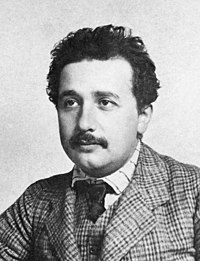Annus mirabilis papers
At the time the papers were written, Einstein did not have easy access to a complete set of scientific reference materials, although he did regularly read and contribute reviews to Annalen der Physik.He worked as an examiner at the Patent Office in Bern, Switzerland, and he later said of a co-worker there, Michele Besso, that he "could not have found a better sounding board for my ideas in all of Europe".In addition, co-workers and the other members of the self-styled "Olympia Academy" (Maurice Solovine and Conrad Habicht) and his wife, Mileva Marić, had some influence on Einstein's work, but how much is unclear.In 1900, Lord Kelvin, in a lecture titled "Nineteenth-Century Clouds over the Dynamical Theory of Heat and Light",[8] suggested that physics had no satisfactory explanations for the results of the Michelson–Morley experiment and for black body radiation.[9] The Nobel committee had waited patiently for experimental confirmation of special relativity; however, none was forthcoming until the time dilation experiments of Ives and Stilwell (1938[10] and 1941[11]) and Rossi and Hall (1941).[12] The article "Über einen die Erzeugung und Verwandlung des Lichtes betreffenden heuristischen Gesichtspunkt" ("On a Heuristic Viewpoint Concerning the Production and Transformation of Light")[einstein 1] received 18 March and published 9 June, proposed the idea of energy quanta.A profound formal difference exists between the theoretical concepts that physicists have formed about gases and other ponderable bodies, and Maxwell's theory of electromagnetic processes in so-called empty space.The article "Über die von der molekularkinetischen Theorie der Wärme geforderte Bewegung von in ruhenden Flüssigkeiten suspendierten Teilchen" ("On the Motion of Small Particles Suspended in a Stationary Liquid, as Required by the Molecular Kinetic Theory of Heat"),[einstein 2] received 11 May and published 18 July, delineated a stochastic model of Brownian motion.Using the kinetic theory of gases, which at the time was controversial, the article established that the phenomenon, which had lacked a satisfactory explanation even decades after it was first observed, provided empirical evidence for the reality of the atom.Wilhelm Ostwald, one of the leaders of the anti-atom school, later told Arnold Sommerfeld that he had been convinced of the existence of atoms by Jean Perrin's subsequent Brownian motion experiments.The paper mentions the names of only five other scientists: Isaac Newton, James Clerk Maxwell, Heinrich Hertz, Christian Doppler, and Hendrik Lorentz.However, Einstein's paper introduces a theory of time, distance, mass, and energy that was consistent with electromagnetism, but omitted the force of gravity.On 21 November Annalen der Physik published a fourth paper (received September 27) "Ist die Trägheit eines Körpers von seinem Energieinhalt abhängig?"



annus mīrābilisAlbert EinsteinAnnalen der Physikmodern physicsscientific publicationsenergyphotoelectric effectNobel Prize in PhysicsBrownian motionEinstein relationspecial theory of relativityspeed of lightLorentz transformationsrelativistic aberrationtransverse Doppler effectmass–energy equivalencenuclear powerquantum mechanicsgeneral theory of relativityEinsteinhausKramgassetheoriesPatent OfficeSwitzerlandMichele BessoOlympia AcademyMaurice SolovineConrad HabichtMileva MarićLord KelvinMichelson–Morley experimentblack bodyquantum theoryMax Planckspecial relativityNobel Prizetime dilationexperiments of Ives and StilwellHeuristicblack-body radiationWien's displacement lawWilhelm Wienluminous energyquantaenergy quantapoints in spaceblack bodiesJames Clerk Maxwellequationselectromagneticinfinite divisibilityPlanck constantNiels BohrArthur ComptonX-ray scattering experimentwave–particle dualityÜber die von der molekularkinetischen Theorie der Wärme geforderte Bewegung von in ruhenden Flüssigkeiten suspendierten Teilchenstochasticmean squared displacementkinetic theory of gasesstatistical mechanicsWilhelm OstwaldArnold SommerfeldJean PerrinMaxwell's equationsIsaac NewtonHeinrich HertzChristian DopplerHendrik Lorentzhistory of special relativityrelativity priority disputeelectromagnetismgravitymoving magnet and conductor problemprinciple of relativityframe of referenceelectrodynamicsopticsconsistentmediumaetherthis sortlight mediummechanicsabsolute restNewtonianclassical mechanicsframes of referenceconjecturepostulatevelocityindependentluminiferous etherkinematicsrigid bodysystems of co-ordinatesclockselectromagnetic processesGeorge FitzGeraldLorentz transformsJoseph LarmorHenri PoincaréGalileo'slaws of naturespacetimeHermann Minkowskikineticpotential energiesHeinrich Rudolf HertzaxiomsMaxwell–Hertz equationsmass–energy relationnuclear reactionschemical explosivesnuclear weaponsnuclear reactorsbinding energynuclear fissionnuclear fusionWorld Year of Physics 2005United NationsPenrose, RogerEinstein, AlbertStachel, JohnPrinceton University PressHolton, Gerald



